
Built in 1845, the Museum Covered Bridge originally spanned the Lamoille River in Cambridge, Vermont. The trusses for the double bridge were assembled in a field next to the chosen site. Measuring 168 feet (51 m) in length, with two vehicle lanes and a footpath, it is an impressive example of the engineering principles and bridge-builder's craft practiced during the 19th century. The bridge was lighted by kerosene lamps.
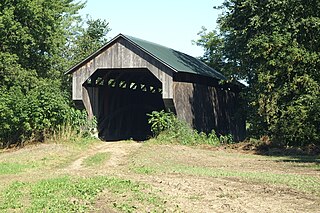
The Gates Farm Covered Bridge is a covered bridge that crosses the Seymour River off State Route 15 in Cambridge, Vermont. Built in 1897, it is last bridge to be built during the historic period of covered bridge construction with the Burr arch design. It was listed on the National Register of Historic Places in 1974.

The East Fairfield Covered Bridge is a covered bridge that carries Bridge Street across Black Creek in the East Fairfield village of Fairfield, Vermont. Built about 1865, it is the town's only surviving 19th century covered bridge. It was listed on the National Register of Historic Places in 1974.

The Poland Covered Bridge, also known as the Junction Covered Bridge or the Cambridge Junction Covered Bridge is a covered bridge that carries Cambridge Junction Road across the Lamoille River off State Route 15 in Cambridge, Vermont. It was listed on the National Register of Historic Places in 1974. The bridge is of Burr arch design, built by George W. Holmes in 1887.

The Grist Mill Covered Bridge, also known as the Scott Covered Bridge, the Bryant Covered Bridge, and the Canyon Covered Bridge, is a covered bridge that carries Canyon Road across the Brewster River, off Vermont Route 108 in Cambridge, Vermont. Built in the 19th century, it is one of a small number of surviving Burr arch truss bridges in the state, and is one of three left in Cambridge. It was listed on the National Register of Historic Places in 1974.

The Cedar Swamp Covered Bridge, also known as the Station Bridge and by various other names, was a historic wooden covered bridge spanning Otter Creek between Cornwall and Salisbury, Vermont. The Town lattice truss bridge was built in 1864-1865 and added to the National Register of Historic Places in 1974. It was destroyed by fire in September 2016.
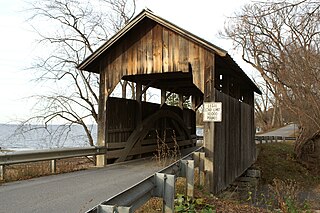
The Holmes Creek Covered Bridge, also called the Lakeshore Covered Bridge, is a one-lane wooden covered bridge that crosses Holmes Creek in Charlotte, Vermont on Lake Road, adjacent to Charlotte Beach. It was listed on the National Register of Historic Places in 1974.

The Pulp Mill Covered Bridge, also called the Paper Mill Covered Bridge, is a wooden covered bridge that crosses Otter Creek between Middlebury and Weybridge, Vermont on Seymour Street. It was listed on the National Register of Historic Places in 1974.

The Great Eddy Covered Bridge, also called the Big Eddy Covered Bridge or Waitsfield Covered Bridge, is a wooden covered bridge that crosses the Mad River in Waitsfield, Vermont on Bridge Street. Built in 1833, it is one of Vermont's oldest covered bridges. It was listed on the National Register of Historic Places in 1974.

The Seguin Covered Bridge, also called the Upper Covered Bridge and the Sequin Covered Bridge, is a wooden covered bridge that crosses Lewis Creek in Charlotte, Vermont on Roscoe Road. It was built about 1850, and is a distinctive variant of a Burr arch design. It was listed on the National Register of Historic Places in 1974.
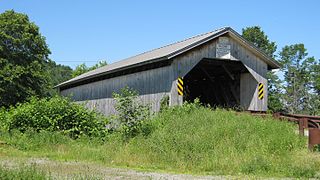
The Hopkins Covered Bridge is a wooden covered bridge that crosses the Trout River in Enosburg, Vermont on Hopkins Bridge Road. Built in 1875 by brothers Sheldon & Savannah Jewett, it is one of a cluster of area covered bridges all attributed to the same builders. It was listed on the National Register of Historic Places in 1974.
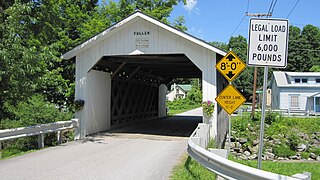
The Fuller Covered Bridge, also known as the Blackfalls Covered Bridge is a wooden covered bridge that crosses Black Falls Brook in Montgomery, Vermont on Fuller Bridge Road. It was listed on the National Register of Historic Places in 1974. The bridge is one of a concentrated regional collection built by brothers Sheldon & Savannah Jewett.

The Longley Covered Bridge, also known as the Harnois Covered Bridge, is a wooden covered bridge that crosses the Trout River in Montgomery, Vermont on Longley Bridge Road. Built in 1863, this Town lattice truss bridge is the oldest of a group of area bridges built by brothers Sheldon & Savannah Jewett. It was listed on the National Register of Historic Places in 1974. The bridge is closed to traffic, and has been bypassed by an adjacent temporary bridge.

The Montgomery Covered Bridge, also known as the Lower Covered Bridge is a wooden covered bridge that carries Montgomery Road across the North Branch of the Lamoille River in Waterville, Vermont. Built in 1887, it is one of three covered bridges in the town, and one of five on the river in a five-mile span. It was listed on the National Register of Historic Places in 1974.

Spanning 114 feet (35 m), the Cabin Creek Covered Bridge crosses Cabin Creek 4.5 miles (7.2 km) northwest of Tollesboro on Kentucky Highway 984 about 12.4 miles from the Lewis-Fleming County line. It is no longer open to vehicular traffic.

The Cooley Covered Bridge is a covered bridge that carries Elm Street across Furnace Brook in Pittsford, Vermont. Built in 1849, it is one of a small number of bridges in the state that has a well-documented association with the 19th-century master bridgewright Nicholas M. Powers, who grew up nearby. It is one of four surviving 19th-century covered bridges in the town, and was listed on the National Register of Historic Places in 1974.

The Gorham Covered Bridge carries Gorham Bridge Road across Otter Creek in a rural area of Pittsford and Proctor, Vermont. It is a Town lattice truss bridge, built in 1841 by Abraham Owen and Nicholas M. Powers, the latter in the early stages of his career as a well-known bridgewright. The bridge was listed on the National Register of Historic Places in 1974.
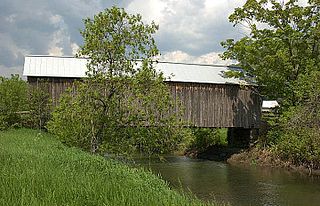
The Howe Covered Bridge is a historic covered bridge carrying Belknap Brook Road across the White River in Tunbridge, Vermont, just east of Vermont Route 110. Built in 1879, it is one of five surviving bridges in the town, one of the highest concentrations of covered bridges in the state. It was listed on the National Register of Historic Places in 1974.

The Hectorville Covered Bridge is a historic covered bridge in Montgomery, Vermont. Originally located on Gibou Road off Vermont Route 118 in central Montgomery, the bridge is currently (2016) in storage. It was built by Sheldon & Savannah Jewett, who are credited with building all of Montgomery's surviving 19th century covered bridges. It was listed on the National Register of Historic Places in 1974.

The Jaynes Covered Bridge is a historic covered bridge, carrying Codding Hollow Road across the North Branch Lamoille River in Waterville, Vermont. Built in 1877, it is one of three 19th-century covered bridges in the town, and one of five to span the North Branch Lamoille in a five-mile span. It was listed on the National Register of Historic Places in 1974.























